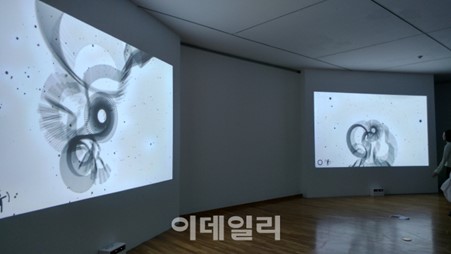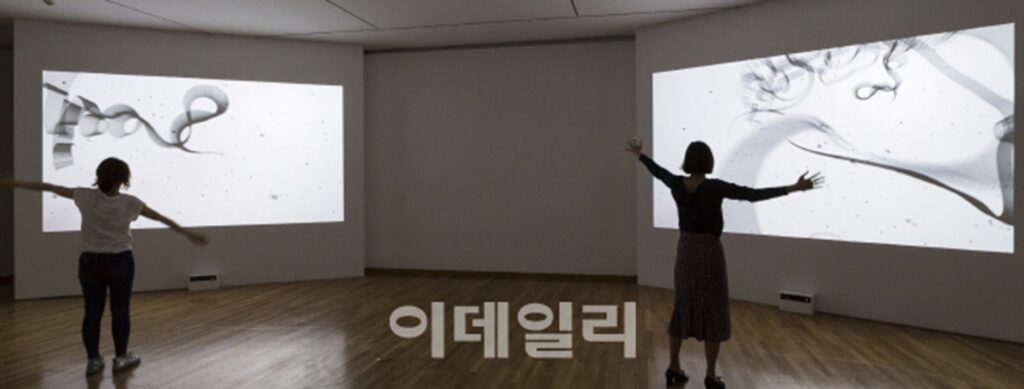- Newspaper translation: edaily
- URL: https://www.edaily.co.kr/news/read?newsId=01144726615932528&mediaCodeNo=257&OutLnkChk=Y
- Date: 2017/05/25
- Author: Hyun-Joo Oh
Eldest son of President Moon, a ‘Media Artist’ .
‘Flying,’ an artwork completed only through audience participation .
Adds emotional depth to motion-sensing technology .
Also develops software himself .
Exhibition ‘Blank Page’ at Kumho Museum showcases 8 pieces by 7 teams until August 31 .

[Edaily Oh Hyun-ju Senior Reporter] Two large windows opened on a monochromatic wall. To be precise, they are giant screens projected by a projector. Each window displays different but similar patterns, repeating rhythmic movements. Twisted ribbons unwind and coil back up, and spiral cones stand up and collapse. Dots embedded in between appear and disappear, keeping time. It looks like what might happen if you dropped a single drop of ink into a cup of clear water.
But this is not the end. The charm of the artwork is that it constantly draws in people around it. When someone stands in front of the screen and spreads their arms wide like gliding, the patterns and dots on the screen respond as if they have been waiting for this moment. It’s as if inviting the person to soar together in the sky. This is the interactive art piece “Flying” (2017), where the artwork and the audience interact and communicate.
Media artist Joon yong Moon (35) has begun “Flying” at the Kumho Museum of Art in Sagan-dong, Jongno-gu, Seoul. He is the son of President Moon Jae-in. This is his first exhibition since his father was elected president. Consequently, whether he likes it or not, he has become an even more “noticed” artist.
In the “Blank Page” exhibition, organized by the museum, eight artists, including Moon, are presenting their video, installation, and media art works. Other participating artists, such as Yang Jung-wook, Kim Joo-ri, Park Jae-young, Park Yeo-joo, Jin Dal-rae & Park Woo-hyuk, and Park Jae-seong, were all born in the late 1970s to early 1980s.
‘Must Communicate’ to Fully Complete the Artwork
The “Blank Page” continues the museum’s series of planned exhibitions since 2012, aiming to provide a new perception of space. This time, a narrative was added. To appreciate the eight exhibited works, viewers need to use not only their vision but also their hearing, touch, and smell, enduring some “inconvenience.” This is a synesthetic experience, an “open stimulus” necessary to access the narratives that the artists want to show and tell.
In this context, Moon’s “Flying” is the piece that most actively engages the viewers. Someone must step forward for the artwork to be fully completed. It epitomizes interactive art, which requires communication to come to life. Here’s how it works: a kinetic sensor inside a small box beneath the screen detects human movements. These movements are directly fed into the program and transformed into images. The images change direction and angle based on the width of the viewer’s outstretched arms and the speed of their flapping motions. Essentially, the viewer’s actions determine the outcome. If you want to see the patterns and rhythms more vividly, you need to flap your arms energetically.

Moon imbued this piece with an emotional storyline—a true digital story. Kim Hee-won, the curator who planned the exhibition, explained, “It’s not just about the artist’s personal experiences,” adding, “He revisited childhood memories, tapping into a universal sense of innocence.” She also noted, “Kinetic art can sometimes feel cold due to its technological aspects, but Moon managed to convey a warm, emotional narrative.”
“Flying” was first presented by Moon in 2009 while he was attending Parsons School of Design in the U.S. The single screen then has now become a dual display, and the software has been particularly refined. Moon developed custom motion-recognition software for this piece. Curator Kim noted that Moon has a high level of understanding of computer technology and programming.
An Artist Gaining Recognition in the Art World for Interactive Art
Moon has had his share of struggles due to the “employment favoritism” controversy. If we set aside his sudden change in status, Moon has been actively exhibiting his works both domestically and internationally since 2010. The art world pays special attention to Moon in the field of interactive art, a subset of media art that uses new technologies to create artworks.
In 2011, he presented the “Makuro Kurosuke Table” at the Gwangju Design Biennale. The piece involved a dust monster appearing and disappearing when the viewer touched the table. The table symbolized a social setting, possibly suggesting the futility of relationships formed solely for networking. Regardless of the underlying theme, it was popular as a “fun piece.”
In 2012, Moon was selected for the Seoul Museum of Art’s Emerging Artist Exhibition Support Program, and he showcased a media work using augmented reality at the “Seoul International Media Art Biennale.” While the work gained attention for its early use of augmented reality, it didn’t receive proper evaluation, overshadowed by his father’s presidential campaign.
Recently, Moon participated in the “Play Art” exhibition at the Pohang Museum of Art, running until July 2. His interactive piece involving movable cubes is drawing many young visitors.
The artists for the “Blank Page” exhibition were selected based on recommendations from art experts in late last year and early this year. It is said that Moon was also invited during this period. Some say Moon’s works, which emphasize “communication,” resemble his father’s focus, but it’s unnecessary to bind him to that expectation. Interactive art is a medium that any artist eager for new expressions would want to explore. The exhibition runs until August 31.